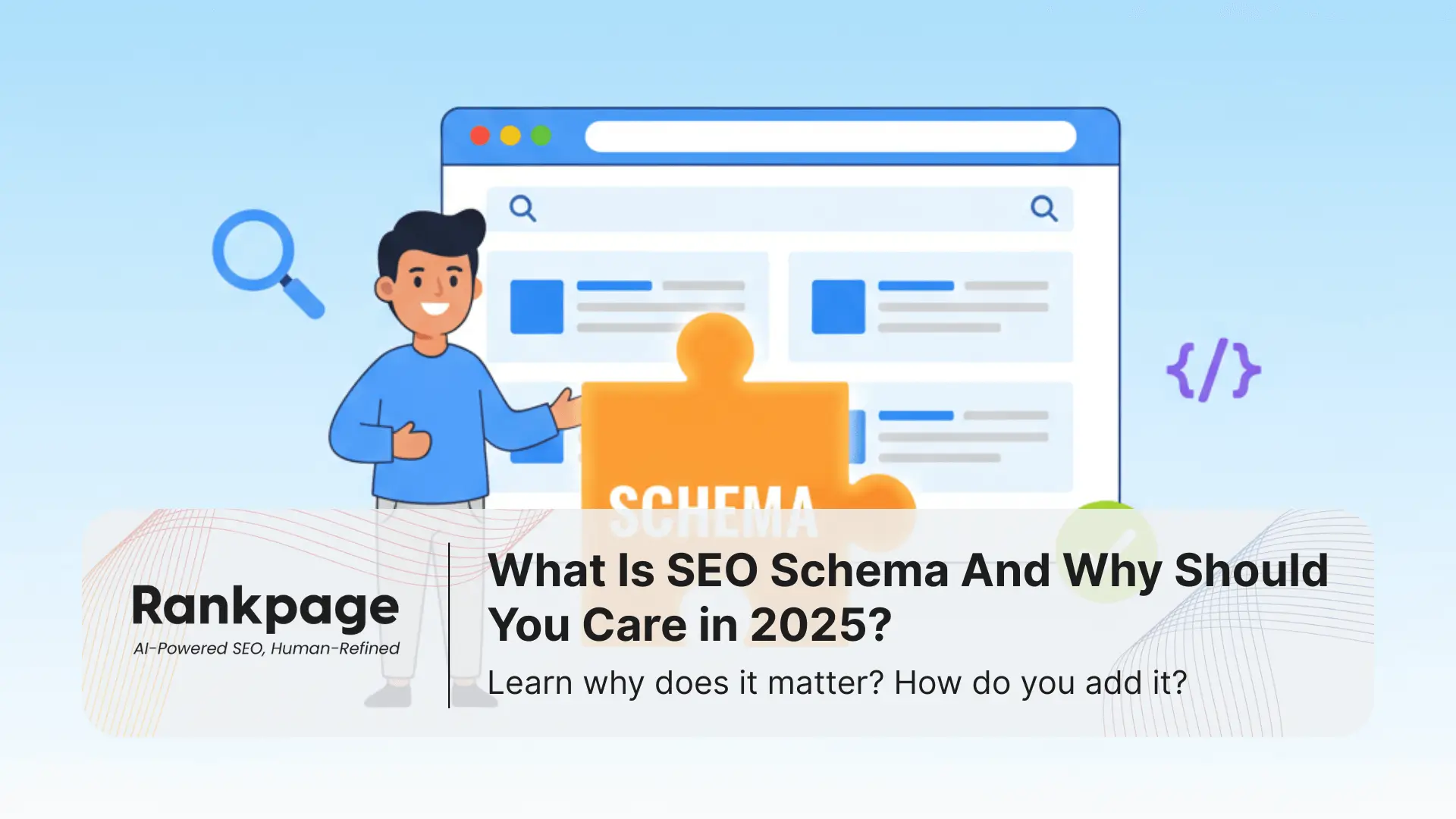Key Takeaways
- Schema markup is invisible code that helps search engines understand your content — like giving Google a cheat sheet about your business.
- It doesn’t boost rankings directly but increases visibility through rich snippets, which can lift click-through rates by up to 30%.
- Top 5 essential types: Article, Local Business, Product, FAQ, and Breadcrumb — cover these first, even if you’re not tech-savvy.
- You can check if your site has Schema using free tools like Google’s Rich Results Test — no coding needed.
- Missing Schema? Start small. One type at a time. Or let experts handle it — your time is better spent running your business.
Table of Contents
You’ve heard “SEO” a hundred times. Maybe you’ve even tried tweaking titles or descriptions. But have you ever wondered why some websites show star ratings, prices, or opening hours right in Google — while yours just shows a plain blue link?
That’s Schema Markup.
It’s not magic. It’s not expensive. And you don’t need to be a developer to benefit from it.
This guide explains what Schema really is, why it matters for your website, which types you actually need, and how to check if you’re missing out — all in plain language. No jargon. No fluff.
Still unsure if this is worth your time? By the end, you’ll know exactly how to make your site stand out in search — even if you’ve never touched code.
🧾 Schema Markup Quick Comparison: What You Need vs. What’s Optional
Schema Type | Best For | Key Benefit |
Article | Blogs, news, guides | Shows publish date & image in results |
Local Business | Shops, clinics, cafes, services | Displays address, phone, hours, map |
Product | E-commerce, online sellers | Shows price, availability, reviews |
FAQ | Service pages, blogs, support | Expands in search with direct Q&A snippets |
Breadcrumb | Any site with multiple pages | Helps users & Google understand site path |
Event | Workshops, promotions, launches | Shows dates & locations in search |
Tip: Start with Local Business or FAQ if you’re new. They’re the easiest to implement and give the fastest visible results.
How Does Schema Markup Actually Work?
Think of Schema as sticky notes you leave for Google.
When Google visits your website, it reads your text, images, and links — but it doesn’t always understand what they mean. Is that number a price? A phone number? A rating?
Schema tells Google: “Hey, this number is our phone. This star rating is from real customers. This date is when the article was published.”
You add tiny bits of code (usually invisible to visitors) that label your content. Google reads those labels and uses them to display richer, more helpful results.
No, it won’t magically shoot you to #1. But it can make your #5 result look 10x more appealing than the #1 result without Schema.
Did My Website Already Have a Schema? How to Check (Free & Easy)
You don’t need to guess. Google gives you free tools to check — in under 60 seconds.
- Go to Google Rich Results Test
- Paste your website URL
- Click “Test URL”
You’ll instantly see:
- ✅ Which Schema types are detected
- ❌ Any errors or warnings
- 👁️ Preview of how your site might appear in search
No login required. No coding. No cost.
If you see nothing — don’t panic. It just means you haven’t added it yet. And that’s fixable.
Here Are the Top Must-Have Schema Types You Should Add to Your Website (Even If You’re Not Technical)
The 5 most essential Schema types every website should have — with simple, copy-paste examples you can use today.
Even if you’re using WordPress, Wix, Shopify, or a basic HTML site.
Quick Reference: Top 5 Schema Types + How Easy They Are to Add
Schema Type | Why You Need It | Shows Up As |
Local Business | Shows address, phone, hours in Google | Map + Info Box |
FAQ | Answers questions directly in search | Expandable Q&A |
Article | Makes blogs look richer with images/dates | Thumbnail + Publish Date |
Product | Displays price, stock, ratings | Price Tag + Stars |
Breadcrumb | Helps users & Google navigate your site | “Home > Services > SEO” |
Start with Local Business or FAQ — they’re the easiest and most visible in search results.
1. Local Business Schema
Ideal for: Cafes, clinics, workshops, salons, contractors, consultants — anyone with a physical location or service area.
This tells Google your business name, address, phone number, and opening hours — so it can show them directly in search.
✅ Simple Script Example (Copy-Paste into your website’s <head> or via plugin)
<script type="application/ld+json">
{
"@context": "https://schema.org",
"@type": "LocalBusiness",
"name": "Your Business Name",
"image": "https://yourwebsite.com/logo.jpg",
"priceRange": "$$",
"address": {
"@type": "PostalAddress",
"streetAddress": "123 Jalan Bukit Bintang",
"addressLocality": "Kuala Lumpur",
"postalCode": "55000",
"addressCountry": "MY"
},
"telephone": "+60312345678",
"openingHoursSpecification": [
{
"@type": "OpeningHoursSpecification",
"dayOfWeek": ["Monday", "Tuesday", "Wednesday", "Thursday", "Friday"],
"opens": "09:00",
"closes": "18:00"
},
{
"@type": "OpeningHoursSpecification",
"dayOfWeek": ["Saturday"],
"opens": "10:00",
"closes": "14:00"
}
]
}
</script>
💡 Replace the details with your own. If you use WordPress, plugins like “Schema Pro” or “Rank Math” let you fill this in via a form — no code needed.
2. FAQ Schema
Ideal for: Service pages, product pages, About Us, Support sections — anywhere you answer common customer questions.
Google will display your FAQs directly in search — like a live Q&A box. Great for voice search too.
✅ Simple Script Example
<script type="application/ld+json">
{
"@context": "https://schema.org",
"@type": "FAQPage",
"mainEntity": [
{
"@type": "Question",
"name": "Do you offer weekend appointments?",
"acceptedAnswer": {
"@type": "Answer",
"text": "Yes, we’re open Saturdays from 10 AM to 2 PM. Closed on Sundays."
}
},
{
"@type": "Question",
"name": "Is delivery free?",
"acceptedAnswer": {
"@type": "Answer",
"text": "Free delivery for all orders above RM100 within Klang Valley."
}
}
]
}
</script>
💡 Add as many Q&As as you want. Just duplicate the Question/Answer block. Works beautifully on mobile and voice search.
3. Article Schema
Ideal for: Blogs, news, guides, tutorials — anything you publish with a date.
Helps Google show your article with an image, headline, and publish date — making it stand out in search results.
✅ Simple Script Example
<script type="application/ld+json">
{
"@context": "https://schema.org",
"@type": "Article",
"headline": "How to Choose the Best Nasi Lemak in KL (2025)",
"image": "https://yourwebsite.com/images/nasi-lemak.jpg",
"author": {
"@type": "Person",
"name": "Your Name",
"url": "https://yourwebsite.com/author-profile"
},
"datePublished": "2025-04-01T08:00:00+08:00",
"dateModified": "2025-04-05T14:30:00+08:00"
}
</script>
💡 Most WordPress SEO plugins (Yoast, Rank Math) auto-generate this when you set a featured image and publish date. Just make sure it’s enabled.
4. Product Schema
Ideal for: E-commerce sites, online sellers, product pages — even if you’re not on Lazada or Shopee.
Shows price, availability, and ratings directly in Google — turning searchers into buyers.
✅ Simple Script Example
<script type="application/ld+json">
{
"@context": "https://schema.org",
"@type": "Product",
"name": "Wireless Bluetooth Earbuds",
"image": "https://yourwebsite.com/images/earbuds.jpg",
"description": "Noise-cancelling wireless earbuds with 20-hour battery life.",
"brand": {
"@type": "Brand",
"name": "YourBrand"
},
"offers": {
"@type": "Offer",
"price": "129.00",
"priceCurrency": "MYR",
"availability": "https://schema.org/InStock",
"url": "https://yourwebsite.com/product/earbuds"
},
"aggregateRating": {
"@type": "AggregateRating",
"ratingValue": "4.8",
"reviewCount": "156"
}
}
</script>
💡 If you have customer reviews, include the rating. If not, remove the “aggregateRating” block. Always include “priceCurrency”: “MYR”.
5. Breadcrumb Schema
Ideal for: Any site with more than 2 pages — helps Google understand your site structure.
Shows a path like “Home > Services > SEO Audit” in search — making your site look more organized and trustworthy.
✅ Simple Script Example
<script type="application/ld+json">
{
"@context": "https://schema.org",
"@type": "BreadcrumbList",
"itemListElement": [
{
"@type": "ListItem",
"position": 1,
"name": "Home",
"item": "https://yourwebsite.com/"
},
{
"@type": "ListItem",
"position": 2,
"name": "Services",
"item": "https://yourwebsite.com/services"
},
{
"@type": "ListItem",
"position": 3,
"name": "SEO Audit",
"item": "https://yourwebsite.com/services/seo-audit"
}
]
}
</script>
💡 Match the position numbers to your page depth. Most modern themes generate this automatically — check your SEO plugin settings.
Need Help Setting Up Schema? Let’s Do It For You.
You’re running a business. You don’t have time to debug code or wrestle with plugins.
We as a SEO Agency help Malaysian SMEs add the right Schema — fast, clean, and error-free. Whether you’re on WordPress, Shopify, Wix, or a custom site, we’ve got you covered.
Frequently Asked Questions About SEO Schema
What is an SEO Schema in simple terms?
SEO Schema is invisible labeling code that helps Google understand and display your content better — so more people click, call, or buy from you.
Does Schema improve my Google ranking?
Not directly. But it makes your listing more eye-catching, which can increase clicks — and more clicks can lead to better rankings over time.
Is Schema hard to add to my website?
No. Most website builders have plugins or settings to add it without coding. We can also do it for you in under a day.
Which Schema type should I add first?
Start with Local Business (if you serve customers locally) or FAQ (if you answer common questions). They’re easiest and give fast results.
Can I use Schema if I’m not selling anything?
Yes. Blogs, portfolios, service sites — all benefit. Article and Breadcrumb Schema work for any site with content or multiple pages.
How do I know if my Schema is working?
Use Google’s Rich Results Test (free). It shows errors, warnings, and a preview of how your site appears in search. Check it anytime.





